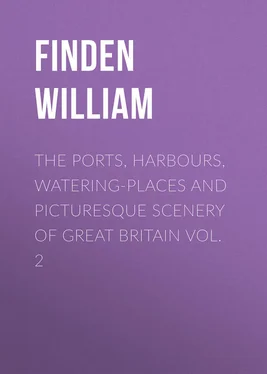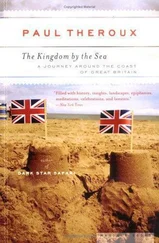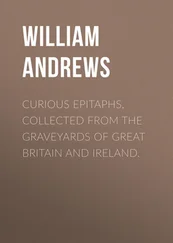William Finden - The Ports, Harbours, Watering-places and Picturesque Scenery of Great Britain Vol. 2
Здесь есть возможность читать онлайн «William Finden - The Ports, Harbours, Watering-places and Picturesque Scenery of Great Britain Vol. 2» — ознакомительный отрывок электронной книги совершенно бесплатно, а после прочтения отрывка купить полную версию. В некоторых случаях можно слушать аудио, скачать через торрент в формате fb2 и присутствует краткое содержание. Жанр: visual_arts, foreign_antique, foreign_prose, на английском языке. Описание произведения, (предисловие) а так же отзывы посетителей доступны на портале библиотеки ЛибКат.
- Название:The Ports, Harbours, Watering-places and Picturesque Scenery of Great Britain Vol. 2
- Автор:
- Жанр:
- Год:неизвестен
- ISBN:нет данных
- Рейтинг книги:3 / 5. Голосов: 1
-
Избранное:Добавить в избранное
- Отзывы:
-
Ваша оценка:
- 60
- 1
- 2
- 3
- 4
- 5
The Ports, Harbours, Watering-places and Picturesque Scenery of Great Britain Vol. 2: краткое содержание, описание и аннотация
Предлагаем к чтению аннотацию, описание, краткое содержание или предисловие (зависит от того, что написал сам автор книги «The Ports, Harbours, Watering-places and Picturesque Scenery of Great Britain Vol. 2»). Если вы не нашли необходимую информацию о книге — напишите в комментариях, мы постараемся отыскать её.
The Ports, Harbours, Watering-places and Picturesque Scenery of Great Britain Vol. 2 — читать онлайн ознакомительный отрывок
Ниже представлен текст книги, разбитый по страницам. Система сохранения места последней прочитанной страницы, позволяет с удобством читать онлайн бесплатно книгу «The Ports, Harbours, Watering-places and Picturesque Scenery of Great Britain Vol. 2», без необходимости каждый раз заново искать на чём Вы остановились. Поставьте закладку, и сможете в любой момент перейти на страницу, на которой закончили чтение.
Интервал:
Закладка:
The Southstack islet is about thirty yards from the rock known as the Head; and on this the lighthouse was erected in 1809, under the direction of Captain Evans, of the Royal Navy. Its form is that of a round tower, the foundation of which is a hundred and forty feet, and the light two hundred feet above the sea – so that it embraces within its sphere the whole bay of Caernarvon. The approach by water to this remarkable sanctuary of human life is well calculated to make a lasting impression upon every visitor, and should never be omitted where a favourable opportunity is presented by the state of the weather. It is here that the extremes of natural desolation and human industry are brought into juxtaposition; where human enterprise has established an asylum amidst the ruins of nature, the war of waves, the wreck of tempests, to shed the "light of hope" over the heart of many a despairing mariner.
Happily for the cause of humanity, vast efforts have been made, and are continually making, to diminish where they cannot entirely remove the dangers which have so long invested our native coast; and it is impossible to calculate the number of lives and the amount of merchandise which have thus been saved from imminent destruction. Much, however, still remains to be effected – much that is really practicable – and it is earnestly to be desired that the attention of Government should be constantly directed to those points on which the science of the engineer can be most beneficially employed. Holyhead in particular is still susceptible of vast improvements; and with the addition of a capacious outer harbour, sufficient to admit merchant-vessels and others of larger size than those now frequenting the port, it would speedily realize all that could be wished for by those most interested in the welfare of the place, and in the prosperity of trade. This is also a subject well deserving of attention on the part of the Admiralty; for, with proper accommodation, her Majesty's ships, in the event of a war, might be advantageously stationed at this port, so as to secure free intercourse, and serve as a protection to the coast, which is now in a defenceless condition and open to any attempt at hostile aggression. We are happy that this question has received the consideration of her Majesty's Government; and feel assured that the steps which are now making towards the accomplishment of so great a desideratum will ensure the grateful approbation of the public, and the increased prosperity of Holyhead.
The Southstack, as already mentioned, is cut off from the promontory by a deep chasm thirty yards in width, through which the sea roars and boils with great force and impetuosity. To cross this formidable ravine an oriental rope-bridge was formerly employed, that is – a sliding basket was attached to the cable, which was secured at either side of the abyss; the passenger entered the basket, and by the ingenious working of lateral pulleys it was sent off or hauled in, according to the arrival or departure of visitors. This hempen apparatus was replaced in 1827 by a handsome suspension-bridge, on the same principles as that over the Menai. It was suggested by the intelligent veteran already mentioned, Captain Evans, and has answered every purpose contemplated in its erection. The roadway is five feet in width, and its height above high-water mark is about seventy feet. The airy span of this bridge is highly graceful and picturesque, and adds greatly to the interest of the picture. On the rock, close under the walls of the lighthouse, are several cottages for the use of the Superintendent and those under his command. The different points of view which it comprises are all deeply interesting to a stranger, particularly from the lighthouse, where the sphere of vision is greatly enlarged.
EAGLE TOWER, CAERNARVON CASTLE
Caernarvon Castle, of which the Engraving annexed presents so faithful and striking a resemblance, is a subject of no ordinary interest: it generally engrosses the attention of all strangers in these parts, and is, in every sense, one of the noblest specimens of castellated architecture in existence. Like so many others of similar design and execution, this fortress owes its origin to the policy of Edward the First, who built it, according to contemporary history, by appropriating the revenues of the See of York, then vacant, to the purposes of warlike enterprise and ambition. The town is understood to have arisen under the same auspices. The Castle defends it on the south by means of a narrow, deep moat in front. In its west wall are three circular towers, with two others on either side, and a narrow gate or entrance, over which is placed a bare-headed figure with flowing locks, – the statue of the founder, – holding in his left hand a sword, which he draws with his right hand, – or rather, perhaps, is returning to its scabbard, in allusion to the subjugation of the Welsh, – and a defaced shield under his feet. This gate leads to a narrow, oblong court. At the west end is a polygon, or many-sided tower, with three others of hexagonal form above, and eagles sculptured on the battlements, from which it received the name, preserved in the Engraving, of the "Eagle Tower." It is a noble structure, having ten sides, and a staircase of three hundred steps to the battlements. In this tower is the birth-chamber of Edward the Second, – the first Prince of Wales, 1 1 The origin of the motto Ich Dien – I serve – is generally attributed to Edward the Black Prince who, in leading the vanguard of his army to the battle of Cressy, slew John of Luxemburg, King of Bohemia, and then deplumed his helmet of those ostrich feathers which, in memory of this victory, became his cognisance , – sometimes using one feather, at others three, as appears on his seals and tomb, with scrolls containing this motto, Ich Dien. But the ancient arms of the princes of Wales, while they were independent sovereigns, were quarterly gules and or , four lions passant , counterchanged. The Charter of Edward the First to his son is dated March 24th, 1305, — i. e. when the Prince had attained his majority.
– whose nativity, on the 25th of April, 1284, was an humiliating epoch to the spirit of Cambrian freedom. The room measures only eleven feet by seven, – dimensions little in accordance with the importance attached to that event, – but still in some measure characteristic of the fortunes of the royal heir, who, after an eventful reign, was destined at last to perish by a horrible death in the dungeon-room of Berkeley Castle. Adjoining this chamber is a semicircular apartment, traditionally described as the King's Nursery.
The Castle and the court which it encloses are very nearly a mile in circumference. From the outside, twelve towers are seen; out of which, as observed in those of Conway Castle, issue several smaller angular turrets, which, relieved against the horizon, produce a very picturesque effect. A gateway on the south side of the Castle is called the Queen's Gate, from the circumstance of Queen Eleanor having entered the fortress through this gate, by a temporary bridge erected for the occasion.
Our limits do not permit us to indulge in more minute description of this vast and imposing fortress, which, from the state of repair in which it is still kept, may brave the changes of season and the fury of the elements for many generations to come. Externally it is still entire, and challenges the admiration of all who have the least taste for what is sublime and striking in architecture. The castle-walls are still washed by the sea on the north and west, as they formerly were on the south. Founded upon a rock, and occupying so strong a position, it might well have been considered impregnable in the absence of gunpowder. Immense as the structure appears, it is said to have been built within the short space of twelve months; a fact which would appear incredible, did we not reflect that in those days of bitter vassalage the will of the sovereign was a law that could not be transgressed without certain destruction to the offenders. If a work was considered impracticable, or of doubtful accomplishment, all hesitation was removed – all difficulties cancelled – by these expressive words, Le Roi l'a voulu! And under the more than magical influence of this laconic phrase, the "towery fortress" of Caernarvon may have sprung into sudden existence.
Читать дальшеИнтервал:
Закладка:
Похожие книги на «The Ports, Harbours, Watering-places and Picturesque Scenery of Great Britain Vol. 2»
Представляем Вашему вниманию похожие книги на «The Ports, Harbours, Watering-places and Picturesque Scenery of Great Britain Vol. 2» списком для выбора. Мы отобрали схожую по названию и смыслу литературу в надежде предоставить читателям больше вариантов отыскать новые, интересные, ещё непрочитанные произведения.
Обсуждение, отзывы о книге «The Ports, Harbours, Watering-places and Picturesque Scenery of Great Britain Vol. 2» и просто собственные мнения читателей. Оставьте ваши комментарии, напишите, что Вы думаете о произведении, его смысле или главных героях. Укажите что конкретно понравилось, а что нет, и почему Вы так считаете.












